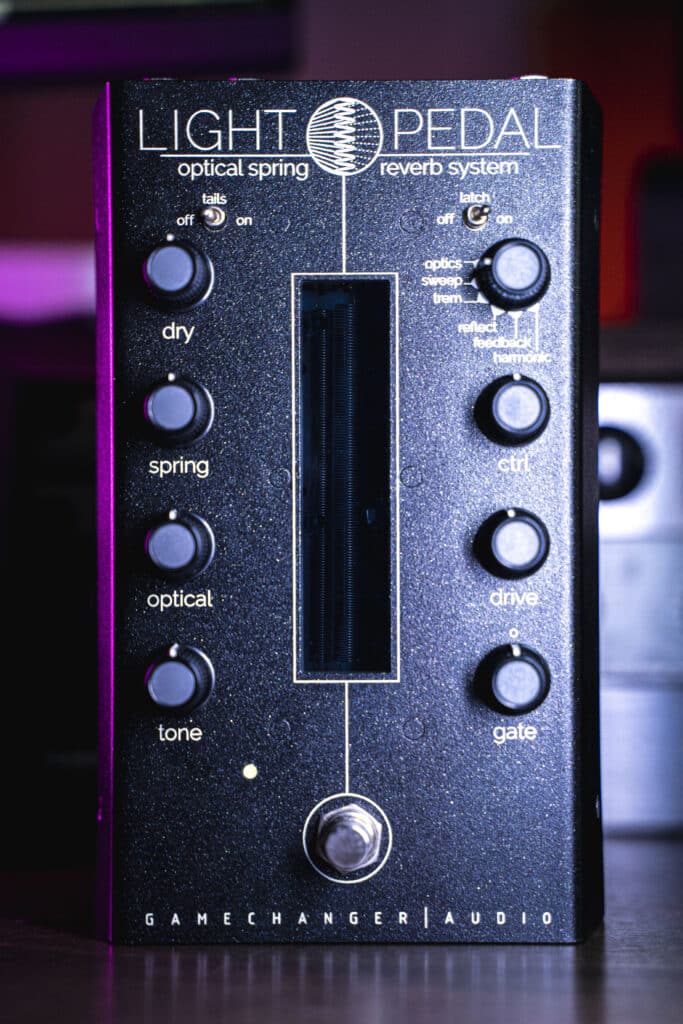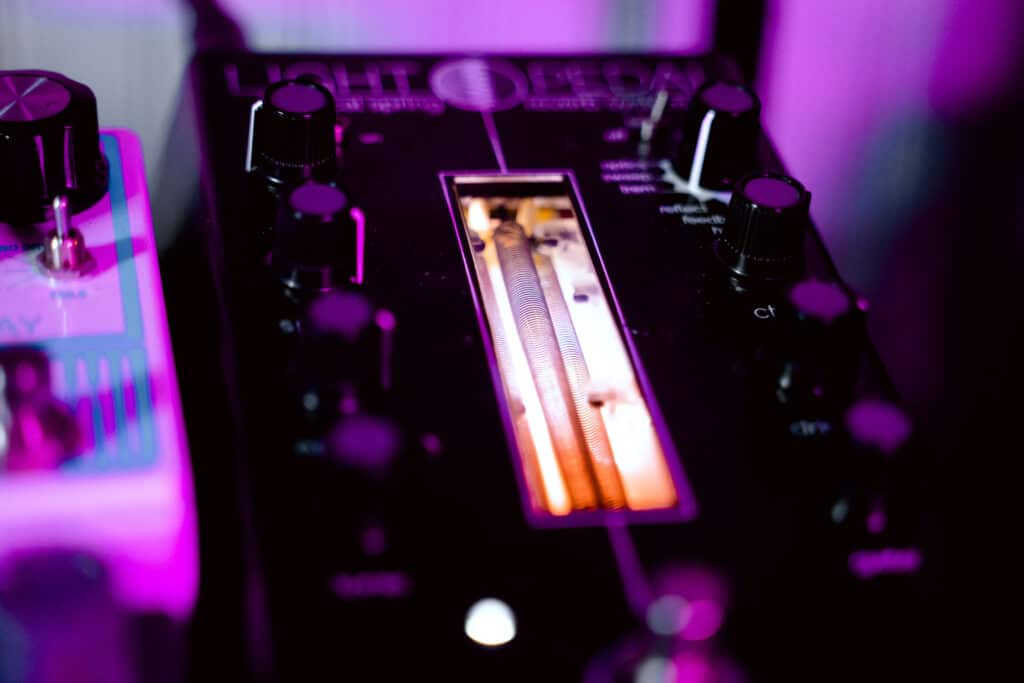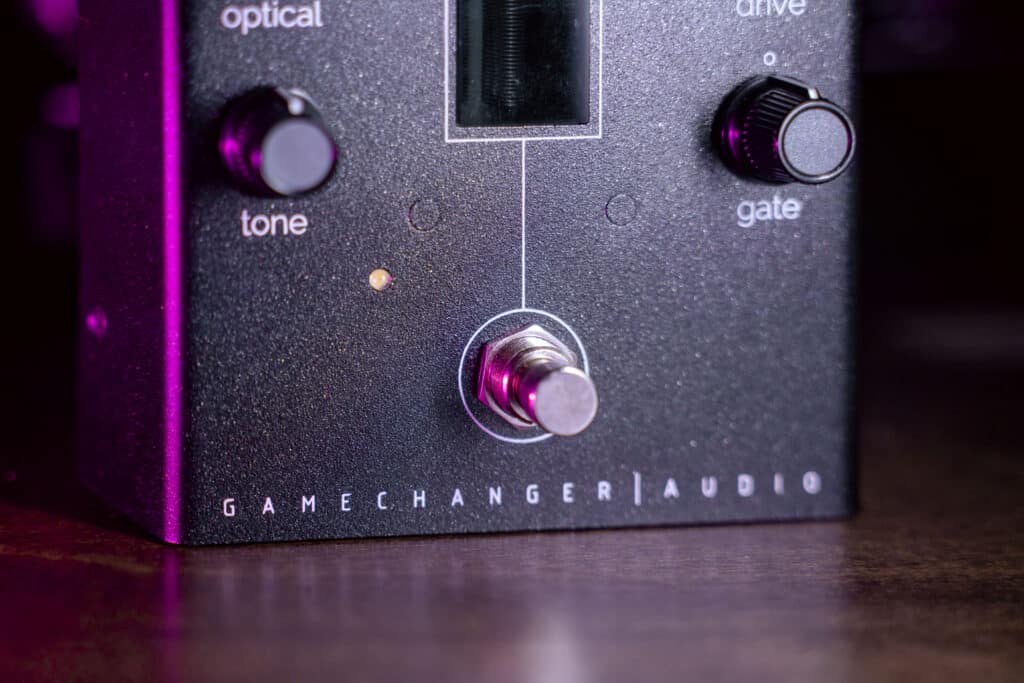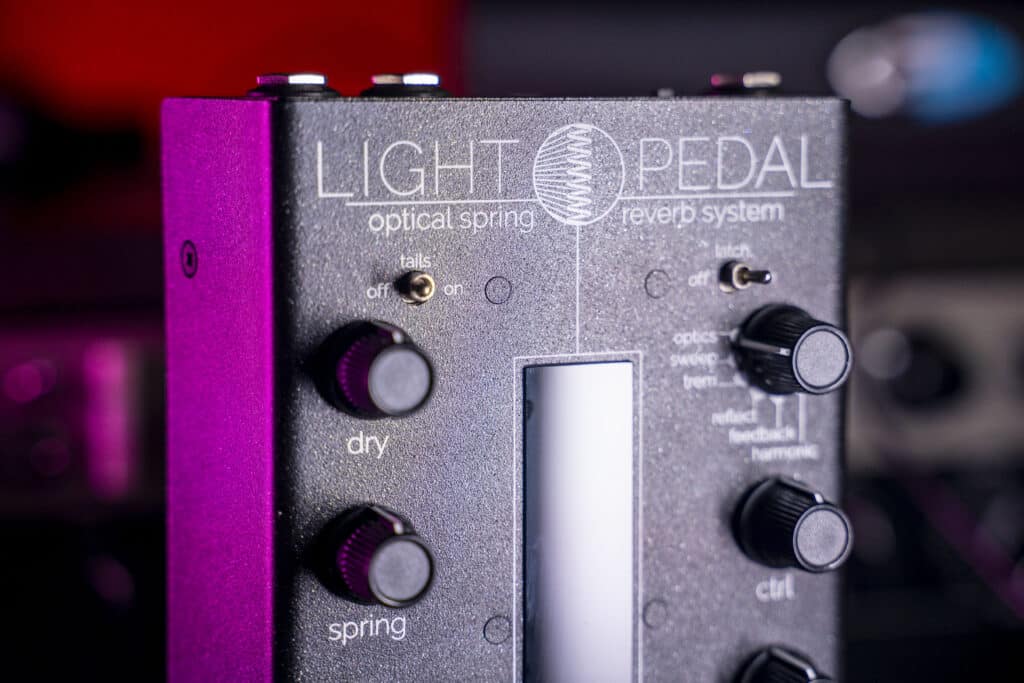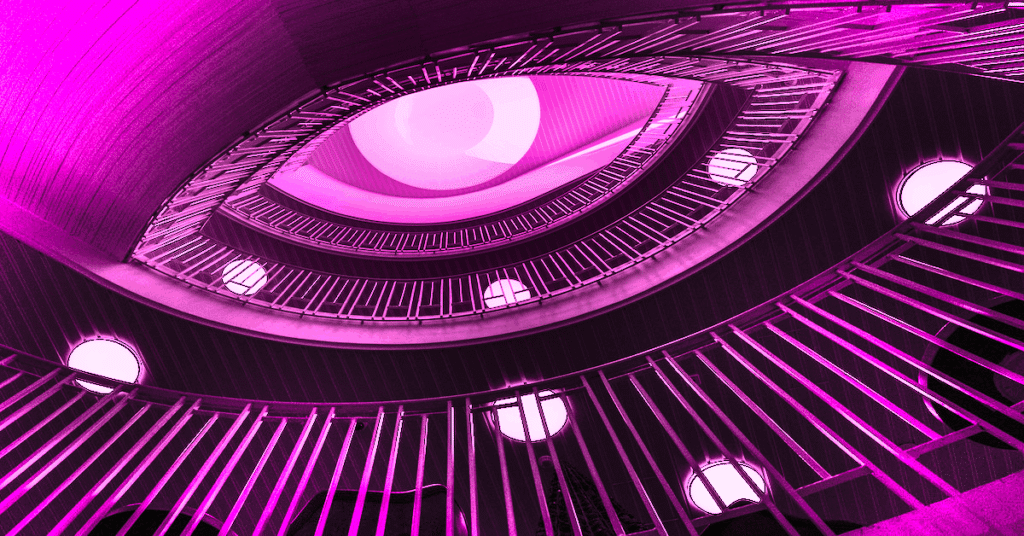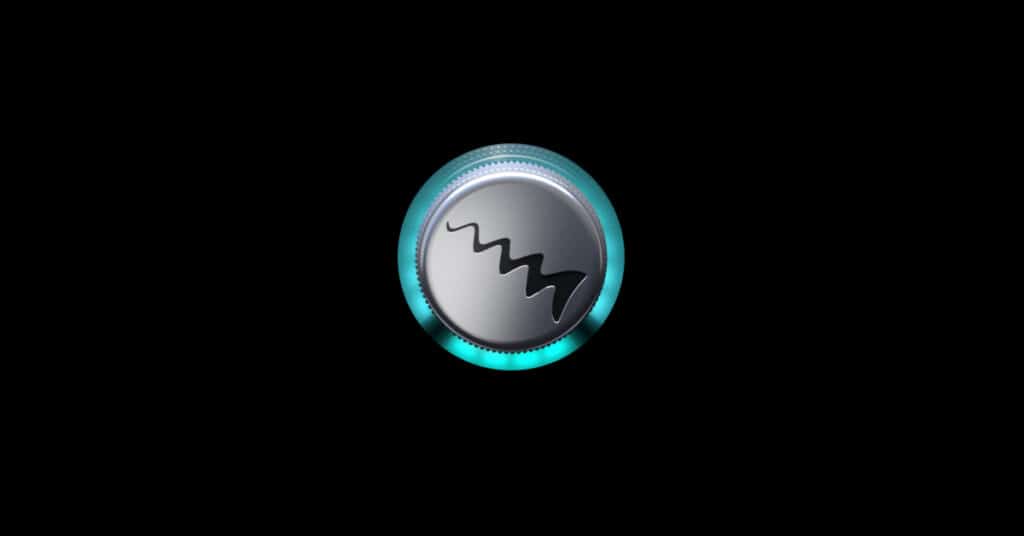OVERVIEW
The Gamechanger Audio LIGHT Pedal isn’t just another reverb pedal—it’s a bold interpretation of the spring reverb effect. As the world’s first analog optical spring reverb system, it combines the mechanical charm of a traditional spring tank with cutting-edge infrared sensor technology. The result is a powerful and sonically versatile tool capable of delivering everything from classic reverb tones to experimental, richly textured soundscapes.
In this article I’ll break down the Gamechanger Audio LIGHT Pedal, exploring it’s controls, and provide audio examples so you can hear it in action.
The Gamechanger Audio LIGHT Pedal is a rugged, studio-grade piece of hardware.
The Classic Spring Reverb Sound
Reverb is one of the most widely used effects for guitarists and audio engineers, and the more time I spend with the LIGHT Pedal, the more impressed I am with how Gamechanger Audio re-conceptualized the effect. At the core of the LIGHT Pedal lies a traditional spring reverb tank. This tank comprises three key components: the input transducer (or spring exciter), the springs themselves, and the output transducer (or pickup). During the reverb process, the springs exhibit complex motion, especially near the point of excitation. However, due to the inherent elasticity of the springs, much of the initial energy dissipates by the time it reaches the output transducer. What remains—and what we typically hear—is the spring’s own resonant frequencies, creating that distinctive jangly, metallic sound associated with classic spring reverbs.
The LIGHT Pedal provides access to this familiar tone through its dedicated Spring output, controllable via the Spring level knob. Users can shape the response further with the Drive control, which adjusts the intensity and character of the reverb (“drip”), and the Tone knob, which tailors the brightness or warmth of the effect.
Obviously the LIGHT Pedal sounds great, and is also a visual stunner.
The Optical Reverb Layer
Where the Gamechanger Audio LIGHT Pedal truly breaks new ground is in its use of multiple infrared optical sensors—an innovation that sets it apart from all other spring reverbs. These sensors, positioned at different points along the spring’s surface, act as highly sensitive photoelectric pickups. Unlike the standard mechanical output transducer, the optical system is capable of detecting the finest nuances of the spring’s movement, capturing a broader spectrum of overtones, subharmonics, and subtle vibrations.
This enhanced sensitivity allows for longer decay times, richer harmonic content, and a range of effects that are simply not possible with traditional spring reverb designs. Through the LIGHT Pedal’s Optical output, users can explore textures that range from smooth and shimmering to experimental and otherworldly. The pedal also includes several dynamic effects—such as modulation, tremolo, and sensor scanning—which manipulate the optical signals to deliver reverb that feels alive, animated, and deeply responsive to both performance and touch.
UNBOXING AND CONSTRUCTION
Right out of the box, the LIGHT Pedal feels like a serious piece of hardware. The build quality is exceptional, with a heavy-duty, sparkly metal chassis and clean industrial design. Its internal LEDs serve a practical purpose, providing real-time visual feedback that enhances both the look and usability of the unit. Immediately, I appreciated its construction and layout, which includes:
-
Rugged metal enclosure with a professional finish
-
Smooth, responsive control knobs and soft-touch footswitch
-
Thoughtfully laid-out interface with intuitive labeling
-
Expression and CV input for expanded control
-
Built to handle studio sessions and live performance environments alike
This is a pedal designed not just for longevity, but for creative exploration. If you’re building a board with a small footprint, you may want to look elsewhere, but the size is absolutely required for what the LIGHT Pedal seeks to achieve, sonically.
CONTROLS AND FEATURES
The LIGHT Pedal offers a wide range of controls that open up a host of sonic possibilities:
-
Independent level controls for Dry, Spring, and Optical signals
-
Tone knob affecting both reverb types
-
Drive knob controls input level to the spring tank
-
Gate knob enables gated or ducking reverb effects
-
6-way effects selector, which I will describe more beneath: Optics, Sweep, Tremolo, Reflect, Feedback, Harmonic
-
CTRL knob adjusts the parameter of the selected effect
-
Expression pedal assignable to five different parameters
-
Multi-effect stacking functionality
-
Tails switch for natural decay or hard cut
-
Momentary or latching operation modes
-
Shock sensor to mute reverb when physical impact is detected
These features allow for an extremely nuanced and responsive performance, whether in the studio or on stage.
Effects Explained
The Gamechanger Audio LIGHT Pedal offers six distinct effects modes, each providing a unique way to shape and manipulate reverb. These are accessible via the mode selector and adjusted using the CTRL knob, which can also be made responsive to playing dynamics. The first three modes are based on the pedal’s optical sensor system, while the latter three interact more directly with the spring tank itself. Notably, you can stack one optical effect with one spring-based effect for complex, layered textures.
Optics Mode
This mode allows you to select specific pairs of optical sensors positioned along the spring. Each pair has a unique timbral character, producing slightly different resonant qualities depending on its location on the spring. This mode is ideal for exploring tonal nuances and uncovering new textures.
Sweep Mode
In Sweep, the pedal rhythmically cycles between different optical sensor pairs. As each sensor responds to a slightly different frequency range, this scanning motion introduces a modulation-like effect that feels organic and fluid. The rate of movement is controlled via the CTRL knob, and the result can range from gentle phasing to dramatic, evolving swells.
Tremolo Mode
Here, the optical sensors are turned on and off rhythmically, creating a tremolo effect. You can apply this effect exclusively to the optical signal or to the spring output as well, allowing for a broad spectrum of rhythmic variations. The tremolo speed is controlled via the CTRL knob, and dynamic responsiveness can further enhance its expressiveness.
Reflect Mode
Reflect acts as a lo-fi delay, sending the input signal through the reverb tank multiple times. By adjusting the delay time using the CTRL knob, you can produce elongated decays and echo effects, ideal for atmospheric layering or dub-style textures.
Feedback Mode
This mode pushes the spring tank into self-oscillation, enabling the creation of dense drones and wall-of-sound-style effects. Feedback is especially effective when paired with an expression pedal or used in momentary mode, letting you inject powerful, resonant bursts into your sound.
Harmonic Mode
In Harmonic mode, the spring tank is driven by a specially designed circuit that enhances its natural resonances. The result is a reverb sound rich in overtones and shimmer-like qualities, all generated organically through the spring itself. It’s perfect for adding ethereal brilliance to any sound source without relying on artificial effects.
APPLICATIONS
While it’s an exceptional reverb for electric guitar, the Gamechanger Audio LIGHT Pedal shines when used in less conventional contexts. It excels as a sound design tool, particularly when paired with:
-
Synthesizers, where the harmonic and optical effects produce lush, evolving textures
-
Re-amped drums, adding lo-fi echoes or feedback for gritty layers
-
Ethereal and haunting vocals, creating cinematic depth with tremolo or reflect effects
The range of available tones makes this pedal as relevant for experimental and ambient music as it is for traditional playing.
The Gamechanger Audio LIGHT Pedal delivers a wide sonic range with clarity and character. The traditional spring reverb sounds are rich and responsive, and some interesting depth can be achieved with the optical layer. These sensors capture subtle details that would normally be lost in the physical tank alone. Have a listen to a variety of sources using the different modes:
Synth Arpeggio (File A is with the pedal bypassed, File B is with the optical mode, File C is with the sweep mode)
Clean Picking Guitar (File A is with the pedal bypassed, File B is with the harmonic mode, File C is with the tremolo mode)
Strummed Guitar Chord (File A is with the pedal bypassed, File B is with the reflect mode, File C is with the optical mode)
House Drum Beat (File A is with the pedal bypassed, File B is with the harmonic mode, File C is with the feedback mode)
Gamechanger Audio LIGHT Pedal SUMMARY
The LIGHT Pedal is more than a reverb—it’s a creative instrument in its own right. I found myself tinkering and tweaking for hours, running all sorts of material beyond electric guitars through it. Its ability to blend traditional and futuristic techniques into a single, intuitive interface makes it one of the most versatile and forward-thinking pedals on the market today. If you’re simply looking for a classic spring reverb sound, while this pedal can handle it, you’re doing yourself a disservice, as the Gamechanger Audio LIGHT Pedal is better suited for dense, ambience, challenging reverb tones that defy tradition.
Strengths:
-
Exceptional build quality
-
Deep, immersive sound design capabilities
-
Flexible routing and control options
-
Useful across multiple instruments and genres
Considerations:
-
Requires a 500mA power supply (not included)
-
May be overkill for those seeking only subtle spring reverb


